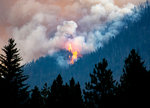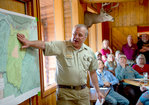Mostly Cloudy and Windy, 54° F
Owners of more than a dozen cabins and the Buffalo Bill Boy Scout Camp have been ordered to evacuate after a wildfire moved rapidly toward the North Fork highway on Wednesday.
This item is available in full to subscribers.
The Powell Tribune has expanded its online content. To continue reading, you will need to either log in to your subscriber account, or purchase a subscription.
If you are a current print subscriber, you can set up a free web account by clicking here.
If you already have a web account, but need to reset it, you can do so by clicking here.
If you would like to purchase a subscription click here.
Please log in to continue |
|





Owners of more than a dozen cabins and the Buffalo Bill Boy Scout Camp have been ordered to evacuate after a wildfire moved rapidly toward the North Fork highway on Wednesday.
The Fishhawk Fire was discovered Monday in the Washakie Wilderness of the Shoshone National Forest, about 40 miles west of Cody and 4 miles south of U.S. Highway 14/16/20. However, it’s grown rapidly amid this week’s hot weather — hitting roughly 2,000 acres by Monday night, 4,581 acres by Tuesday night then exploding to 10,321 acres on Wednesday night.
It was shortly after 8 p.m. Wednesday that the Park County Sheriff’s Office issued a mandatory evacuation notice for cabin owners in the Kitty Creek drainage and the scout camp.
“A mandatory evacuation notice means that residents of cabins/residences in these areas need to leave the area immediately due to the encroaching Fishhawk Fire,” the sheriff’s office wrote in a Facebook post. “Property can be replaced. Human lives cannot.”
Fishhawk Fire managers said they patrolled and monitored the fire overnight, “with resources readily available if needed.” On Thursday, they planned to continue working to protect structures, including building fire line around buildings in Kitty Creek and working to protect nearby lodges.
A Type 2 incident management team, the Rocky Mountain Incident Management Blue Team, assumed command of fire operations at 6 a.m. Thursday. As of Thursday, they had 72 personnel, two fixed-wing aircraft and four helicopters assisting with the Fishhawk Fire.
Powell Volunteer Fire Department personnel were notified Wednesday night that they might be asked for assistance on the wildfire, but they ultimately were not summoned to the scene.
A combination of hot, dry conditions and wind have fueled the fire’s growth. The fire is burning in “rough, nasty terrain” and moving toward the North Fork of the Shoshone River corridor, which is loaded with residences and businesses.
Mark Giacoletto, Shoshone National Forest fire management officer, said at a Tuesday night meeting in Wapiti that firefighters have a moderate to high chance of success to protect structures in the corridor.
“The fire is going to be here for a while, probably for the next four to six weeks. It has the potential to march down here and park,” Giacoletto said. “Our objective is to protect the values here and to suppress the fire when we can and where we can.”
While there are a few fires being fought nationally, the season has been light compared with recent years.
“What does that mean? Our access to whatever resources we need is what we’ll get,” Giacoletto said.
The meeting with representatives from the Shoshone and area emergency crews drew a standing room-only crowd at the Yellowstone Valley Inn.
The team, which has experience fighting area fires, tried their best to assure the crowd that their properties were safe for the moment.
“We’re going to do what we need to do to keep that fire up the hill and keep from getting to those values and risks in the corridor,” said Sue Stresser, district ranger for the Shoshone National Forest.
The fire are in rough terrain loaded with fuel — trees killed by disease.
“We don’t want to put firefighters in the wilderness right now because of steep terrain. It’s dangerous. All that dead material and snags — it just doesn’t make sense,” Stresser said. “We’re not going to put firefighters where they can’t be effective and can’t be safe.”
Meanwhile, a smaller blaze, the Stinkingwater Fire near the Sulphur Creek area of Sunlight Basin, was already being hit with aerial suppression efforts by midday Tuesday. Lightning is suspected as the cause of both fires.
Tuesday’s meeting in Wapiti was scheduled quickly in hopes of controlling the spread of rumors.
“We were getting calls today in my office saying things like we heard the East Gate [to Yellowstone] is shut,” said Stresser.
The gate was open Wednesday as the Fishhawk and Stinkingwater fires continued burning.
"It is a priority of the incident to keep the North Fork corridor open to the public," Fishhawk Fire managers said Thursday morning. The highway remained open, but manager warned "that smoke may impede travel, so reduced speeds may be necessary."
“Our priorities are people — to make sure people are safe,” Stresser said Tuesday. She said efforts were made to locate hunters and outfitters in the area. Park County Commissioner Lee Livingston, himself an outfitter, said none were in immediate danger, though hunters were nearby on Kitty and Sheep Creeks between the Fishhawk and Blackwater trails.
“All indications are there is no one in Fishhawk itself,” he said.
Drawing from his experience with fires, Livingston said the Fishhawk Fire “could be a Type 1 pretty quick,” referring to the most complex type of fire. With lots of dead timber in the area, “it could get Western,” Livingston said.
Officials are hoping for rain and cooler temperatures through the weekend. “That would be good and slow the advance of the fire,” Giacoletto said.
Fishhawk Trail, Kitty Creek Trail and Blackwater Trail were closed for public safety.
Four smaller fires are burning in remote areas of Yellowstone National Park.
With all the smoke, the air quality in the Cody area was “very poor” on Wednesday morning, said Park County Public Health Nurse Manager Bill Crampton. “We’ve got some sensitive groups who will definitely be affected.”
Wildfire smoke is made up of a variety of pollutants that can cause respiratory health effects, especially to children, the elderly and people with existing respiratory conditions, such as asthma, the Wyoming Department of Environmental Quality says. When air quality is poor, “people in these sensitive groups should limit outdoor activities,” the department says.